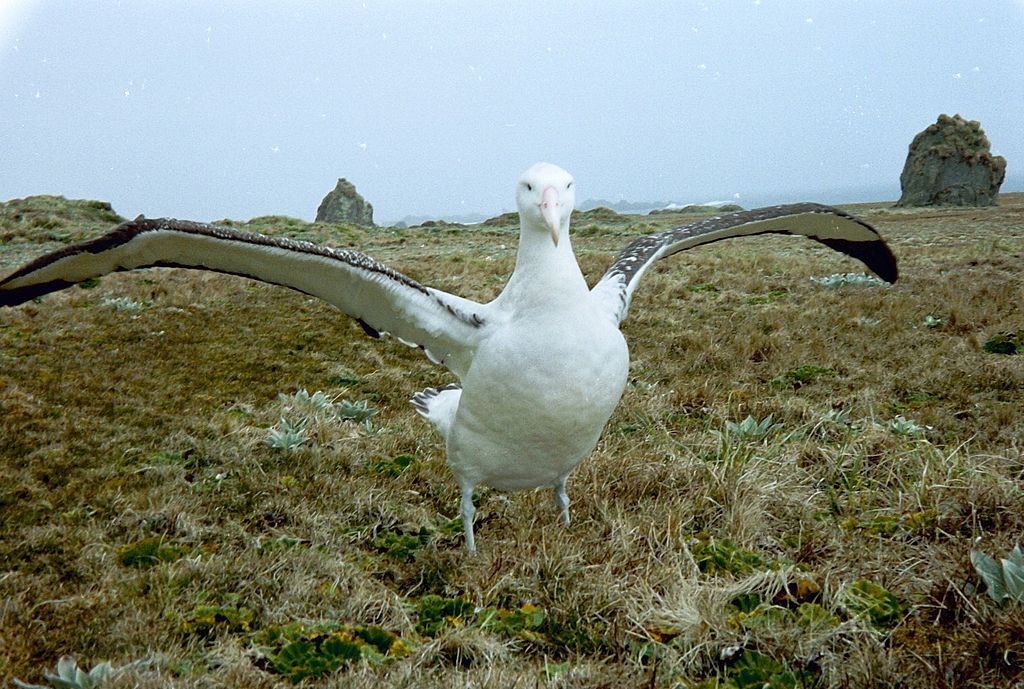Want to know where hard-to-find squid live? Ask their predators
Look, sometimes you need to "offload water" from a giant albatross...for science
Curiosity and the search for answers are what drive scientists, sometimes to extreme lengths. A great example of just how far scientists will go is the research team that went to the Antarctic and set out to find where squid live by attaching GPSs to the large seabirds that eat them.
There are about 300 different squid species in the world, but scientists have yet to determine where all of them can be found. This gap in knowledge is unfortunate, because that information would allow researchers to start discovering the role they play in various food chains as well as to follow environmental and marine shifts through movement of these cephalopod populations.
Squid in the Southern Ocean, which surrounds Antarctica, are especially elusive. They are fast swimmers, and they live in a vast and remote open ocean habitat, including at its depths (up to 7,236 meters, or 23,740 feet). These squid are rarely caught in scientific nets. But one group of animals is good at tracking them down: the ones who eat them. Jorge Pereira, Vitor Paiva, and Jose Xavier, all at Universidade de Coimbra in Portugal, used wandering albatrosses in their study "Using seabirds to map the distribution of elusive pelagic cephalopod species" published in March.

An enormous wandering albatross
Using predators to track prey isn't a novel idea, but it is a brilliant one. It has been used by scientists in the Southern Ocean since at least the early 1990s. Many predators are, by nature, trackers. What better way for scientists to find prey species of interest than to let a predator lead the way to them?
There are some unique biases to consider when using a method like this. For example, the predator may prefer a specific size of prey and therefore only lead you to juveniles or adults. In addition, predators may only forage in certain areas that overlap with the prey species range, thereby revealing only part of the area they live in. However, it's a reliable method, and as one of the best options for these situations, scientists adopt a "beggars can't be choosers" mentality.
A team of scientists took advantage of the wandering albatrosses who rear their chicks on Bird Island, in southern Georgia. Wandering albatrosses are incredibly charismatic birds. They are some of the largest birds in the world and hold the record for largest wingspan (up to 11.5 feet). These albatrosses forage over great areas, including the cold waters of the Antarctic, but also the sub-Antarctic and subtropical regions. They can soar for several hours without flapping their wings and they spend most of their life in the air, only landing to breed and eat. They mostly feed on fish and cephalopods, but also on crustaceans, and catch their food during dives or when their prey is near the surface. They are listed as vulnerable by the International Union for Conservation of Nature (IUCN), so if climate change affected their food sources, the entire species could be endangered.
The scientists outfitted 17 of them with a GPS logger, activity recorder, and stomach temperature probe for a single foraging journey. The combination of information they gleaned allowed them to piece together a story of the journey.
As the albatrosses journeyed, searching for food to bring back to their chicks, the GPS tracked their locations. When a bird would dive into the water to capture prey, the activity logger would record it. When an albatross ingested prey, that prey item was colder than the normal body temperature of the bird, causing the temperature logged by the stomach temperature probe to drop.
When the bird returned, the researchers used a method called water off-loading to collect the contents of their stomachs. They inserted a tube through the bird's bill until it reaches the stomach, pour warm water in until the stomach is full, then remove the tube and massage the bird's stomach until it vomits into a bucket (this process is repeated twice to ensure all contents were flushed from the stomach). The scientists then went through that vomit to identify what the albatross had eaten. Sometimes science isn't pretty, and it often smells bad.
The researchers found 22 squid specimens representing 11 species. Then, working backwards from the sizes and masses of the squid bits, researchers mapped the distribution of various species in the Southern Ocean.
.jpg)
The surprising Galitheuthis glacialis
Some of their findings surprised them. One species, Galiteuthis glacialis, was found across an oceanic front, the boundary between distinct water masses that move in different directions and often have different temperatures, salinities, and densities. Scientists previously thought that cephalopods did not cross oceanic fronts. If a species can cross them, it means they can survive in more diverse areas than previously thought and that these squid are not held back by these physical barriers.
In the future, the authors wrote that they would like to take the study even further, adding another item to the technological outfit of the albatrosses: small cameras. Of course, that means that, in addition to wading through vomit, they'll be able to watch the albatrosses catch prey. It will make identifying what they ate much easier and address some questions that they can't with the current system. For example, some fishermen in this area use one species of squid as bait, so it's possible the albatross pick them up from behind fishing boats and the squid don't actually live in that area.
Conducting scientific research can be dirty, smelly, and uncomfortable at times, but making new discoveries about how the world works makes these extreme measures well worth it.